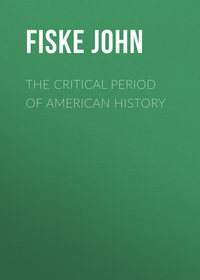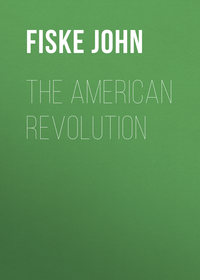 полная версия
полная версияA Century of Science, and Other Essays
We are then brought, I say, to the secret of Parkman's power. His Indians are true to the life. In his pages Pontiac is a man of warm flesh and blood, as much so as Montcalm or Israel Putnam. This solid reality in the Indians makes the whole work real and convincing. Here is the great contrast between Parkman's work and that of Prescott, in so far as the latter dealt with American themes. In reading Prescott's account of the conquest of Mexico, one feels one's self in the world of the "Arabian Nights;" indeed, the author himself, in occasional comments, lets us see that he is unable to get rid of just such a feeling.
His story moves on in a region that is unreal to him, and therefore tantalizing to the reader; his Montezuma is a personality like none that ever existed beneath the moon. This is because Prescott simply followed his Spanish authorities not only in their statements of physical fact, but in their inevitable misconceptions of the strange Aztec society which they encountered; the Aztecs in his story are unreal, and this false note vitiates it all. In his Peruvian story Prescott followed safer leaders in Garcilasso de la Vega and Cieza de Leon, and made a much truer picture; but he lacked the ethnological knowledge needful for coming into touch with that ancient society, and one often feels this as the weak spot in a narrative of marvellous power and beauty.
Now it was Parkman's good fortune at an early age to realize that in order to do his work it was first of all necessary to know the Indian by personal fellowship and contact. It was also his good fortune that the right sort of Indians were still accessible. What would not Prescott have given, what would not any student of human evolution give, for a chance to pass a week or even a day in such a community as the Tlascala of Xicotencatl or the Mexico of Montezuma! That phase of social development has long since disappeared. But fifty years ago, on our great western plains and among the Rocky Mountains, there still prevailed a state of society essentially similar to that which greeted the eyes of Champlain upon the St. Lawrence and of John Smith upon the Chickahominy. In those days the Oregon Trail had changed but little since the memorable journey of Lewis and Clark in the beginning of the present century. In 1846, two years after taking his bachelor degree at Harvard, young Parkman had a taste of the excitements of savage life in that primeval wilderness. He was accompanied by his kinsman, Mr. Quincy Shaw. They joined a roving tribe of Sioux Indians, at a time when to do such a thing was to take their lives in their hands, and they spent a wild summer among the Black Hills of Dakota and in the vast moorland solitudes through which the Platte River winds its interminable length. In the chase and in the wigwam, in watching the sorcery of which their religion chiefly consisted, or in listening to primitive folk tales by the evening camp fire, Parkman learned to understand the red man, to interpret his motives and his moods. With his naturalist's keen and accurate eye and his quick poetic apprehension, that youthful experience formed a safe foundation for all his future work. From that time forth he was fitted to absorb the records and memorials of the early explorers, and to make their strange experiences his own.
The next step was to gather these early records from government archives, and from libraries public and private, on both sides of the Atlantic, – a task, as Parkman himself called it, "abundantly irksome and laborious." It extended over many years and involved several visits to Europe. It was performed with a thoroughness approaching finality. Already in the preface to the "Pioneers" the author was able to say that he had gained access to all the published materials in existence. Of his research among manuscript sources a notable monument exists in a cabinet now standing in the library of the Massachusetts Historical Society, containing nearly two hundred folio volumes of documents copied from the originals by expert copyists. Ability to incur heavy expense is, of course, a prerequisite for all undertakings of this sort, and herein our historian was favoured by fortune. Against this chiefest among advantages were to be offset the hardships entailed by delicate health and inability to use the eyes for reading and writing. Parkman always dictated instead of holding the pen, and his huge mass of documents had to be read aloud to him. The heroism shown year after year in contending with physical ailments was the index of a character fit to be mated, for its pertinacious courage, with the heroes that live in those shining pages.
The progress in working up materials was slow and sure. "The Conspiracy of Pontiac," which forms the sequel and conclusion of Parkman's work, was first published in 1851, only five years after the summer spent with the Indians; fourteen years then elapsed before the "Pioneers" made its appearance in Little, Brown & Co.'s window; and then there were yet seven-and-twenty years more before the final volumes came out in 1892. Altogether, about half a century was required for the building of this grand literary monument. Nowhere can we find a better illustration of the French critic's definition of a great life, – a thought conceived in youth, and realized in later years.
This elaborateness of preparation had its share in producing the intense vividness of Parkman's descriptions. Profusion of detail makes them seem like the accounts of an eye-witness. The realism is so strong that the author seems to have come in person fresh from the scenes he describes, with the smoke of the battle hovering about him and its fierce light glowing in his eyes. Such realism is usually the prerogative of the novelist rather than of the historian, and in one of his prefaces Parkman recognizes that the reader may feel this and suspect him. "If at times," he says, "it may seem that range has been allowed to fancy, it is so in appearance only, since the minutest details of narrative or description rest on authentic documents or on personal observation."
This kind of personal observation Parkman carried so far as to visit all the important localities, indeed well-nigh all the localities, that form the scenery of his story, and study them with the patience of a surveyor and the discerning eye of a landscape painter. His strong love of nature added keen zest to this sort of work. From boyhood he was a trapper and hunter; in later years he became eminent as a horticulturist, originating new varieties of flowers. To sleep under the open sky was his delight. His books fairly reek with the fragrance of pine woods. I open one of them at random, and my eye falls upon such a sentence as this: "There is softness in the mellow air, the warm sunshine, and the budding leaves of spring; and in the forest flower, which, more delicate than the pampered offspring of gardens, lifts its tender head through the refuse and decay of the wilderness." Looking at the context, I find that this sentence comes in a remarkable passage suggested by Colonel Henry Bouquet's western expedition of 1764, when he compelled the Indians to set free so many French and English prisoners. Some of these captives were unwilling to leave the society of the red men; some positively refused to accept the boon of what was called freedom. In this strange conduct, exclaims Parkman, there was no unaccountable perversity; and he breaks out with two pages of noble dithyrambics in praise of savage life. "To him who has once tasted the reckless independence, the haughty self-reliance, the sense of irresponsible freedom, which the forest life engenders, civilization thenceforth seems flat and stale… The entrapped wanderer grows fierce and restless, and pants for breathing room. His path, it is true, was choked with difficulties, but his body and soul were hardened to meet them; it was beset with dangers, but these were the very spice of his life, gladdening his heart with exulting self-confidence, and sending the blood through his veins with a livelier current. The wilderness, rough, harsh, and inexorable, has charms more potent in their seductive influence than all the lures of luxury and sloth. And often he on whom it has cast its magic finds no heart to dissolve the spell, and remains a wanderer and an Ishmaelite to the hour of his death."26
No one can doubt that the man who could write like this had the kind of temperament that could look into the Indian's mind and portray him correctly. But for this inborn temperament all his microscopic industry would have availed him but little. To use his own words: "Faithfulness to the truth of history involves far more than a research, however patient and scrupulous, into special facts. Such facts may be detailed with the most minute exactness, and yet the narrative, taken as a whole, may be unmeaning or untrue." These are golden words for the student of the historical art to ponder. To make a truthful record of a vanished age patient scholarship is needed, and something more. Into the making of a historian there should enter something of the philosopher, something of the naturalist, something of the poet. In Parkman this rare union of qualities was realized in a greater degree than in any other American historian. Indeed, I doubt if the nineteenth century can show in any part of the world another historian quite his equal in respect of such a union.
There is one thing which lends to Parkman's work a peculiar interest, and will be sure to make it grow in fame with the ages. Not only has he left the truthful record of a vanished age so complete and final that the work will never need to be done again, but if any one should in future attempt to do it again he cannot approach the task with quite such equipment as Parkman. In an important sense, the age of Pontiac is far more remote from us than the age of Clovis or the age of Agamemnon. When barbaric society is overwhelmed by advancing waves of civilization, its vanishing is final; the thread of tradition is cut off forever with the shears of Fate. Where are Montezuma's Aztecs? Their physical offspring still dwell on the table-land of Mexico, and their ancient speech is still heard in the streets, but that old society is as extinct as the trilobites, and has to be painfully studied in fossil fragments of custom and tradition. So with the red men of the North: it is not true that they are dying out physically, as many people suppose, but their stage of society is fast disappearing, and soon it will have vanished forever. Soon their race will be swallowed up and forgotten, just as we overlook and ignore to-day the existence of five thousand Iroquois farmers in the state of New York.
Now the study of comparative ethnology has begun to teach us that the red Indian is one of the most interesting of men. He represents a stage of evolution through which civilized men have once passed, – a stage far more ancient and primitive than that which is depicted in the Odyssey or in the Book of Genesis. When Champlain and Frontenac met the feathered chieftains of the St. Lawrence, they talked with men of the Stone Age face to face. Phases of life that had vanished from Europe long before Rome was built survived in America long enough to be seen and studied by modern men. Behind Mr. Parkman's picturesqueness, therefore, there lies a significance far more profound than one at first would suspect. He has portrayed for us a wondrous and forever fascinating stage in the evolution of humanity. We may well thank Heaven for sending us such a scholar, such an artist, such a genius, before it was too late. As we look at the changes wrought in the last fifty years, we realize that already the opportunities by which he profited in youth are in large measure lost. He came not a moment too soon to catch the fleeting light and fix it upon his immortal canvas.
Thus Parkman is to be regarded as first of all the historian of Primitive Society. No other great historian has dealt intelligently and consecutively with such phases of barbarism as he describes with such loving minuteness. To the older historians all races of men very far below the European grade of culture seemed alike; all were ignorantly grouped together as "savages." Mr. Lewis Morgan first showed the wide difference between true savages, such as the Apaches and Bannocks on the one hand, and barbarians with developed village life, like the Five Nations and the Cherokees. The latter tribes in the seventeenth and eighteenth centuries exhibited social phenomena such as were probably witnessed about the shores of the Mediterranean some seven or eight thousand years earlier. If we carry our thoughts back to the time that saw the building of the Great Pyramid, and imagine civilized Egypt looking northward and eastward upon tribes of white men with social and political ideas not much more advanced than those of Frontenac's red men, our picture will be in its most essential features a correct one. What would we not give for a historian who, with a pen like that of Herodotus, could bring before us the scenes of that primeval Greek world before the cyclopean works at Tiryns were built, when the ancestors of Solon and Aristides did not yet dwell in neatly joinered houses and fasten their door-latches with a thong, when the sacred city-state was still unknown, and the countryman had not yet become a bucolic or "tender of cows," and butter and cheese were still in the future! No written records can ever take us back to that time in that place; for there, as everywhere in the eastern hemisphere, the art of writing came many years later than the domestication of animals, and some ages later than the first building of towns. But in spite of the lack of written records, the comparative study of institutions, especially comparative jurisprudence, throws back upon those prehistoric times a light that is often dim, but sometimes wonderfully suggestive and instructive. It is a light that reveals among primeval Greeks ideas and customs essentially similar to those of the Iroquois. It is a light that grows steadier and brighter as it leads us to the conclusion that five or six thousand years before Christ white men around the Ægean Sea had advanced about as far as the red men in the Mohawk Valley two centuries ago. The one phase of this primitive society illuminates the other, though extreme caution is necessary in drawing our inferences. Now Parkman's minute and vivid description of primitive society among red men is full of lessons that may be applied with profit to the study of preclassic antiquity in the Old World. No other historian has brought us into such close and familiar contact with human life in such ancient stages of its progress. In Parkman's great book we have a record of vanished conditions such as hardly exists anywhere else in literature.
I say his great book, using the singular number; for, with the exception of that breezy bit of autobiography, "The Oregon Trail," all Parkman's books are the closely related volumes of a single comprehensive work. From the adventures of "The Pioneers of France" a consecutive story is developed through "The Jesuits in North America" and "The Discovery of the Great West." In "The Old Régime in Canada" it is continued with a masterly analysis of French methods of colonization in this their greatest colony, and then from "Frontenac and New France under Louis XIV." we are led through "A Half-Century of Conflict" to the grand climax in the volumes on "Montcalm and Wolfe," after which "The Conspiracy of Pontiac" brings the long narrative to a noble and brilliant close. In the first volume we see the men of the Stone Age at that brief moment when they were disposed to adore the bearded newcomers as Children of the Sun; in the last we read the bloody story of their last and most desperate concerted effort to loosen the iron grasp with which these palefaces had seized and were holding the continent. It is a well-rounded tale, and as complete as anything in real history, where completeness and finality are things unknown.
Between the beginning and the end of this well-rounded tale a mighty drama is wrought out in all its scenes. The struggle between France and England for the soil of North America was one of the great critical moments in the career of mankind, – no less important than the struggle between Greece and Persia, or between Rome and Carthage. Out of the long and complicated interaction between Roman and Teutonic institutions which made up the history of the Middle Ages, two strongly contrasted forms of political society had grown up and acquired aggressive strength when in the course of the sixteenth century a New World beyond the sea was laid open for colonization. The maritime nations of Europe were naturally the ones to be attracted to this new arena of enterprise; and Spain, Portugal, France, England, and Holland each played its interesting and characteristic part. Spain at first claimed the whole, excepting only that Brazilian coast which Borgia's decree gave to Portugal. But Spain's methods, as well as her early failure of strength, prevented her from making good her claim. Spain's methods were limited to stepping into the place formerly occupied by the conquering races of half-civilized Indians. She made aboriginal tribes work for her, just as the Aztec Confederacy and the Inca dynasty had done. Where she was brought into direct contact with American barbarism without the intermediation of half-civilized native races, she made little or no headway. Her early failure of strength, on the other hand, was due to her total absorption in the fight against civil and religious liberty in Europe. The failure became apparent as soon as the absorption had begun to be complete. Spain's last aggressive effort in the New World was the destruction of the little Huguenot colony in Florida in 1565, and it is at that point that Parkman's great work appropriately begins. From that moment Spain simply beat her strength to pieces against the rocks of Netherland courage and resourcefulness. As for the Netherlands, their energies were so far absorbed in taking over and managing the great Eastern empire of the Portuguese that their work in the New World was confined to seizing upon the most imperial geographical position, and planting a cosmopolitan colony there that, in the absence of adequate support, was sure to fall into the hands of one or the other of the competitors more actively engaged upon the scene.
The two competitors thus more actively engaged were France and England, and from an early period it was felt between the two to be a combat in which no quarter was to be given or accepted. These two strongly contrasted forms of political society had each its distinct ideal, and that ideal was to be made to prevail, to the utter exclusion and destruction of the other. Probably the French perceived this somewhat earlier than the English; they felt it to be necessary to stamp out the English before the latter had more than realized the necessity of defending themselves against the French. For the type of political society represented by Louis XIV. was preëminently militant, as the English type was preëminently industrial. The aggressiveness of the former was more distinctly conscious of its own narrower aims, and was more deliberately set at work to attain them, while the English, on the other hand, rather drifted into a tremendous world fight without distinct consciousness of their purpose. Yet after the final issue had been joined, the refrain Carthago delenda est was heard from the English side, and it came fraught with impending doom from the lips of Pitt as in days of old from the lips of Cato.
The French idea, had it prevailed in the strife, would not have been capable of building up a pacific union of partially independent states, covering this vast continent from ocean to ocean. Within that rigid and rigorous bureaucratic system there was no room for spontaneous individuality, no room for local self-government, and no chance for a flexible federalism to grow up. A well-known phrase of Louis XIV. was, "The state is myself." That phrase represented his ideal. It was approximately true in Old France, realized as far as sundry adverse conditions would allow. The Grand Monarch intended that in New France it should be absolutely true. Upon that fresh soil was to be built up a pure monarchy without concession to human weaknesses and limitations. It was a pet scheme of Louis XIV., and never did a philanthropic world-mender contemplate his grotesque phalanstery or pantarchy with greater pleasure than this master of kingcraft looked forward to the construction of a perfect Christian state in America.
The pages of our great historian are full of examples which prove that if the French idea failed of realization, and the state it founded was overwhelmed, it was not from any lack of lofty qualities in individual Frenchmen. In all the history of the American continent no names stand higher than some of the French names. For courage, for fortitude and high resolve, for sagacious leadership, statesmanlike wisdom, unswerving integrity, devoted loyalty, for all the qualities which make life heroic, we may learn lessons innumerable from the noble Frenchmen who throng in Parkman's pages. The difficulty was not in the individuals, but in the system; not in the units, but in the way they were put together. For while it is true – though many people do not know it – that by no imaginable artifice can you make a society that is better than the human units you put into it, it is also true that nothing is easier than to make a society that is worse than its units. So it was with the colony of New France.
Nowhere can we find a description of despotic government more careful and thoughtful, or more graphic and lifelike, than Parkman has given us in his volume on "The Old Régime in Canada." Seldom, too, will one find a book fuller of political wisdom. The author never preaches like Carlyle, nor does he hurl huge generalizations at our heads like Buckle; he simply describes a state of society that has been. But I hardly need say that his description is not – like the Dryasdust descriptions we are sometimes asked to accept as history – a mere mass of pigments flung at random upon a canvas. It is a picture painted with consummate art; and in this instance the art consists in so handling the relations of cause and effect as to make them speak for themselves. These pages are alive with political philosophy, and teem with object lessons of extraordinary value. It would be hard to point to any book where History more fully discharges her high function of gathering friendly lessons of caution from the errors of the past.
Of all the societies that have been composed of European men, probably none was ever so despotically organized as New France, unless it may have been the later Byzantine Empire, which it resembled in the minuteness of elaborate supervision over all the pettiest details of life. In Canada the protective, paternal, socialistic, or nationalistic theory of government – it is the same old cloven hoof, under whatever specious name you introduce it – was more fully carried into operation than in any other community known to history except ancient Peru. No room was left for individual initiative or enterprise. All undertakings were nationalized. Government looked after every man's interests in this world and the next: baptized and schooled him; married him and paid the bride's dowry; gave him a bounty with every child that was born to him; stocked his cupboard with garden seeds and compelled him to plant them; prescribed the size of his house and the number of horses and cattle he might keep, and the exact percentages of profit he might be allowed to make, and how his chimneys should be swept, and how many servants he might employ, and what theological doctrine he might believe, and what sort of bread the bakers might bake, and where goods might be bought and how much might be paid for them; and if in a society so well cared for it were possible to find indigent persons, such paupers were duly relieved, from a fund established by government. Unmitigated benevolence was the theory of Louis XIV.'s Canadian colony, and heartless political economy had no place there. Nor was there any room for free thinkers; when the King after 1685 sent out word that no mercy must be shown to heretics, the governor, Denonville, with a pious ejaculation, replied that not so much as a single heretic could be found in all Canada.
Such was the community whose career our historian has delineated with perfect soundness of judgment and wealth of knowledge. The fate of this nationalistic experiment, set on foot by one of the most absolute of monarchs and fostered by one of the most devoted and powerful of religious organizations, is traced to the operation of causes inherent in its very nature. The hopeless paralysis, the woeful corruption, the moral torpor, resulting from the suppression of individualism, are vividly portrayed; yet there is no discursive generalizing, and from moment to moment the development of the story proceeds from within itself. It is the whole national life of New France that is displayed before us. Historians of ordinary calibre exhibit their subject in fragments, or they show us some phases of life and neglect others. Some have no eyes save for events that are startling, such as battles and sieges; or decorative, such as coronations and court balls. Others give abundant details of manners and customs; others have their attention absorbed by economics; others again feel such interest in the history of ideas as to lose sight of mere material incidents. Parkman, on the other hand, conceives and presents his subject as a whole. He forgets nothing, overlooks nothing; but whether it is a bloody battle, or a theological pamphlet, or an exploring journey though the forest, or a code for the discipline of nunneries, each event grows out of its context as a feature in the total development that is going on before our eyes. It is only the historian who is also philosopher and artist that can thus deal in block with the great and complex life of a whole society. The requisite combination is realized only in certain rare and high types of mind, and there has been no more brilliant illustration of it than Parkman's volumes afford.







